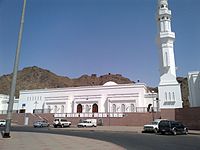
| Part of a series on:
Salafi movement |
|---|
 |
|
|
The Wahhabi movement started as a revivalist and reform movement in the Arabian Peninsula during the early 18th century, whose adherents described themselves as "Muwahhidun" (Unitarians).[a] A young Hanbali cleric named Muhammad ibn ʿAbd al-Wahhab (1703–1792 C.E/ 1115-1206 A.H), the leader of the Muwahhidun and eponym of the Wahhabi movement, called upon his disciples to denounce certain beliefs and practices associated with cult of saints as idolatrous impurities and innovations in Islam (bid'ah).[3][5] His movement emphasized adherence to the Quran and hadith, and advocated the use of ijtihad.[2] Eventually, Ibn 'Abd al-Wahhab formed a pact with a local leader, Muhammad bin Saud, offering political obedience and promising that protection and propagation of the Wahhabi movement meant "power and glory" and rule of "lands and men".[6]
18th and 19th century European historians, scholars, travellers and diplomats compared the Wahhabi movement with various Euro-American socio-political movements in the Age of Revolutions. Calvinist scholar John Ludwig Burckhardt, author of the well-received works “Travels in Arabia” (1829) and “Notes on the Bedouins and Wahábys” (1830), described the Muwahhidun as Arabian locals who resisted Turkish hegemony and its “Napoleonic” tactics. Historian Loius Alexander Corancez in his book “Histoire des Wahabis” described the movement as an Asiatic revolution that sought a powerful revival of Arab civilisation by establishing a new order in Arabia and cleansing all the irrational elements and superstitions which had been normalised through Sufi excesses from Turkish and foreign influences. Scottish historian Mark Napier attributed the successes of Ibn ‘Abd al-Wahhab’s revolution to assistance from “frequent interpositions of Heaven".[7]
After the Unification of Saudi Arabia, Wahhabis were able spread their political power and consolidate their rule over the Islamic holy cities of Mecca and Medina. After the discovery of petroleum near the Persian Gulf in 1939, Saudi Arabia had access to oil export revenues, revenue that grew to billions of dollars. This money – spent on books, media, schools, universities, mosques, scholarships, fellowships, lucrative jobs for journalists, academics and Islamic scholars – gave Wahhabi ideals a "preeminent position of strength" in Islam around the world.[8]
- ^ Kjeilen, Tore (2001). Encyclopaedia of the Orient: Wahhabism/Muwahhidun.
- ^ a b Mark Juergensmeyer; Wade Clark Roof, eds. (2011). "Wahhabis". Encyclopedia of Global Religion. Sage Publications. p. 1369. ISBN 978-1452266565.
- ^ a b Haykel, Bernard (2013). "Ibn ‛Abd al-Wahhab, Muhammad (1703–92)". In Böwering, Gerhard; Crone, Patricia; Kadi, Wadad; Mirza, Mahan; Stewart, Devin J.; Zaman, Muhammad Qasim (eds.). The Princeton Encyclopedia of Islamic Political Thought. Princeton, NJ: Princeton University Press. pp. 231–32. ISBN 978-069113484-0. Retrieved 15 June 2020.
- ^ Commins 2006, p. 7.
- ^ Esposito 2003, p. 333
- ^ Lacey 2009, pp. 10–11. "the two ... concluded a pact. Ibn Saud would protect and propagate the stern doctrines of the Wahhabi mission, which made the Koran the basis of government. In return, Abdul Wahhab would support the ruler, supplying him with 'glory and power'. Whoever championed his message, he promised, 'will, by means of it, rule and lands and men'."
- ^ Bonacina, Giovanni (2015). The Wahhabis Seen through European Eyes (1772–1830): Deists and Puritans of Islam. Koninklijke Brill nv, Leiden, The Netherlands: Brill. pp. 5–10, 72–73, 97. ISBN 978-90-04-29301-4.
- ^ Kepel 2006, pp. 61–62.
Cite error: There are <ref group=lower-alpha> tags or {{efn}} templates on this page, but the references will not show without a {{reflist|group=lower-alpha}} template or {{notelist}} template (see the help page).
© MMXXIII Rich X Search. We shall prevail. All rights reserved. Rich X Search
